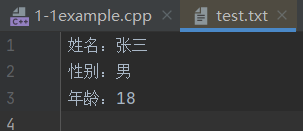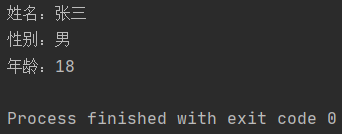本博文是学习黑马程序员C++视频时做的笔记,记录一下只是方便温故知新,不做其他用途。
1、 程序运行时产生的数据都属于临时数据,程序一旦运行结束都会被释放,通过文件可以将数据持久化。
2、 C++中对文件操作需要包含头文件 < fstream >。
3、 文件类型分为两种:
(1)文本文件 - 文件以文本的ASCII码形式存储在计算机中
(2)二进制文件 - 文件以文本的二进制形式存储在计算机中,用户一般不能直接读懂它们
4、 操作文件的三大类:
(1)ofstream:写操作
(2)ifstream: 读操作
(3)fstream : 读写操作
一、文本文件
1.1 写文件
1、写文件步骤:
(1)包含头文件
#include <fstream>
(2)创建流对象
ofstream ofs;
(3)打开文件
ofs.open(“文件路径”,打开方式);
(4)写数据
ofs << “写入的数据”;
(5)关闭文件
ofs.close();
2 、常见的打开方式
| 打开方式 | 解释 |
|---|---|
| ios::in | 为读文件而打开文件 |
| ios::out | 为写文件而打开文件 |
| ios::ate | 初始位置:文件尾 |
| ios::app | 追加方式写文件 |
| ios::trunc | 如果文件存在先删除,再创建 |
| ios::binary | 二进制方式 |
#include <iostream>
using namespace std;
//1 头文件包含
#include <fstream>
void test01()
{
// 2 创建流对象
ofstream ofs;
// 3 打开文件
ofs.open("test.txt", ios::out);
// 4 写入文件
ofs << "姓名:张三" << endl;
ofs << "性别:男" << endl;
ofs << "年龄:18" << endl;
// 5 关闭文件
ofs.close();
}
int main()
{
test01();
return 0;
}

1.2 读文件
1、读文件步骤:
(1)包含头文件
#include <fstream>
(2)创建流对象
ifstream ifs;
(3)打开文件
ifs.open(“文件路径”,打开方式);
(4)写数据
四种方式读取
(5)关闭文件
ifs.close();
#include <iostream>
using namespace std;
#include <string>
//1 包含头文件
#include <fstream>
//读文件
void test01()
{
// 2 创建流对象
ifstream ifs;
// 3 打开文件
ifs.open("test.txt", ios::in);
if (!ifs.is_open())//判断是否打开成功
{
cout << "文件打开失败" << endl;
return;
}
第一种方式
// char buf[1024] = { 0 };
// while (ifs >> buf)
// {
// cout << buf << endl;
// }
//第二种
//char buf[1024] = { 0 };
//while (ifs.getline(buf,sizeof(buf)))
//{
// cout << buf << endl;
//}
//第三种
string buf;
while (getline(ifs, buf)) //4 读取数据
{
cout << buf << endl;
}
//第四种
// char c;
// while ((c = ifs.get()) != EOF)//
// {
// cout << c;
// }
// 5 关闭文件
ifs.close();
}
int main()
{
test01();
return 0;
}

二、二进制文件
以二进制的方式对文件进行读写操作,打开方式要指定为 ios::binary。
2.1 写文件
二进制方式写文件主要利用流对象调用成员函数write。
函数原型 :ostream& write(const char * buffer,int len);
参数解释:字符指针buffer指向内存中一段存储空间。len是读写的字节数。
#include <iostream>
using namespace std;
#include <string>
//1、包含头文件
#include <fstream>
//二进制文件 写文件
class Person
{
public:
char m_Name[64];//姓名
int m_Age;//年龄
};
void test01()
{
//2、创建输出流对象
ofstream ofs;
//3、打开文件
ofs.open("person.txt", ios::out | ios::binary);
//4、写文件
Person p = {"张三" , 18};
ofs.write((const char *)&p, sizeof(p));
//5、关闭文件
ofs.close();
}
int main()
{
test01();
return 0;
}
2.2 读文件
二进制方式读文件主要利用流对象调用成员函数read。
函数原型:*istream& read(char buffer,int len);
参数解释:字符指针buffer指向内存中一段存储空间。len是读写的字节数。
#include <iostream>
using namespace std;
#include <string>
//1、包含头文件
#include <fstream>
//二进制 读文件
class Person
{
public:
char m_Name[64];
int m_Age;
};
void test01()
{
// 2 创建流对象
ifstream ifs;
// 3 打开文件 判断是否打开成功
ifs.open("person.txt", ios::in | ios::binary);
if (!ifs.is_open())
{
cout << "文件打开失败" << endl;
return;
}
// 4 读文件
Person p;
ifs.read((char *)&p, sizeof(p));
cout << "姓名: " << p.m_Name << " 年龄: " << p.m_Age << endl;
// 5 关闭文件
ifs.close();
}
int main()
{
test01();
return 0;
}






















 4089
4089











 被折叠的 条评论
为什么被折叠?
被折叠的 条评论
为什么被折叠?








